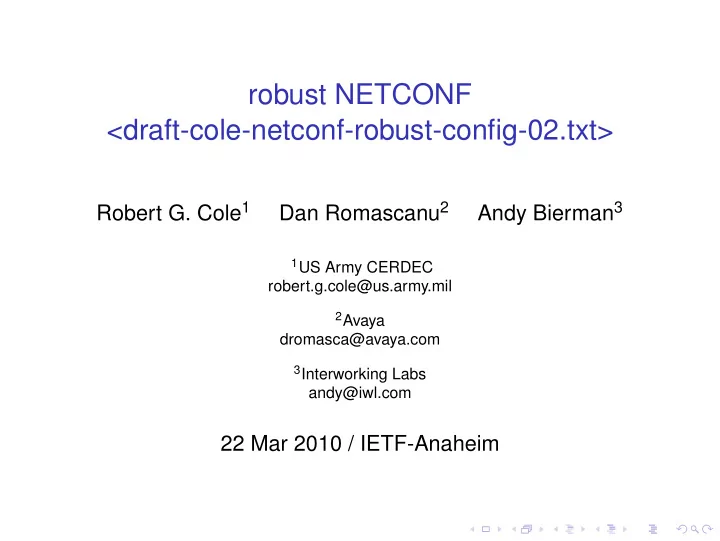

robust NETCONF <draft-cole-netconf-robust-config-02.txt> Robert G. Cole 1 Dan Romascanu 2 Andy Bierman 3 1 US Army CERDEC robert.g.cole@us.army.mil 2 Avaya dromasca@avaya.com 3 Interworking Labs andy@iwl.com 22 Mar 2010 / IETF-Anaheim
objectives and benefits Definitions: • Validation - checking against a set of rules, e.g., all checks prior to moving configuration to <running/>. • Verification - measuring behavior (of <running/>) against expectations. Objectives: • Minimize faulty configuration, • Minimize disconnects in networks with no ’out-of-band’ access, e.g., MANETs or DTNs, and • Develop inter-operable mechanisms for verification testing.
changes from 01 to 02 • Version 01 had originally proposed to couple verify with <commit> through a <verified-commit> operation. • It was proposed on the mailing list (i.e., M. Bjorklund) to decouple the verify operation, which we have done in ver-02. • ver-02 defines the new verify.yang module which is to be advertised according to the YANG specification [2]. • The module verify.yang defines: • Operations - < verify > , < cancel-verify > , and < complete-verify > , • Notifications - < verificationStatus > and < verificationComplete > , and • Requirements - on inter-operable test.yang modules.
verify.yang • Pushes verification testing to the server. • Multi-stage operation, i.e., < verify > , < complete-verify > and < cancel-verify > • ‘Verification test suite’ comprised of multiple ‘test sets’ per < verify > operation. • Multiple parameters, i.e., test-templates instanceIds, verbose reporting and test period. • Multiple notifications, i.e., <verificationStatus> and <verificationComplete>.
< verify > example Client Server o edit-config in target | | |--------------------->| | set test control | o defines specific | | tests for <verify> |<---------------------| | OK(’instanceID’) | | | | | o start network verification |--------------------->| | <verify> w/ | o initiate network | <timeout=’60’/> | verification tests | <test-template= | | ’instanceID’/> | |<---------------------| | OK | | | o send notification |<---------------------| | <verificationStatus= | | ’good’/> | | | o send final |<---------------------| notification o network verification |<verificationComplete=| complete | ’success’/> | • A simple <verify> test example.
<cancel-verify> operation Client Server o start network verification |--------------------->| | <verify> w/ | o initiate network | <timeout=’60’/> | verification tests | <test-template= | | ’instanceID’/> | |<---------------------| | OK | | | o send notification |<---------------------| | <verificationStatus= | | ’failing’/> | o terminate verification | | |--------------------->| | <cancel-verify> | o immediately stops | | verification tests • A <verify> test gone bad. • Client issues a <cancel-verify> operation to immediately terminate tests.
example ping.yang Defined an example, simple test module for discussion • ping.yang module defined in appendix of draft • verify.yang places requirements on the development of inter-operable test modules as identified in the draft, i.e., • Test sets contained in a leaf-list indexed via instanceID. • Pass/fail determinations of Test Set results and test suite results. • Raw results contained in leaf-list. • ping.yang represents an extremely simple example; extensible test.yang modules being developed.
Questions Questions • ? Next Steps • Flesh out more extensive test modules in YANG.
References 1 Cole, R.G., Romascanu, D. and A. Beirman, Robust NETCONF , IETF Draft, <draft-cole-robust-netconf-02.txt>, March 2010. 2 Bjorklund, M., YANG - A data modeling language for NETCONF , IETF Draft, <draft-ietf-netmod-yang-11.txt>, February 2010.
Recommend
More recommend